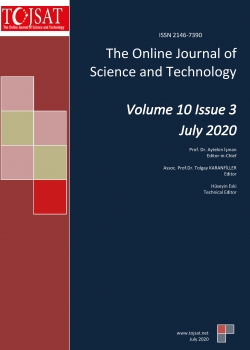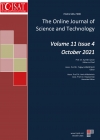TOJSAT - Volume 10 - Issue 3 - July 2020
 DESIGN OF A TEACHING-LEARNING SEQUENCE TO FACILITATE TRANSITION BETWEEN QUALITATIVE AND QUANTITATIVE REASONING ABOUT KINEMATICS PHENOMENA
DESIGN OF A TEACHING-LEARNING SEQUENCE TO FACILITATE TRANSITION BETWEEN QUALITATIVE AND QUANTITATIVE REASONING ABOUT KINEMATICS PHENOMENA Louis TRUDEL, Abdeljalil MÉTIOUI, Gilbert ARBEZ
Abstract:
Science experiments offered to the pupils in physics classrooms generally do not take into account their alternative conceptions in relation to physical phenomena so that they can encounter difficulties in identifying pertinent factors and expressing it in the form of quantitative equations (Ploetzner & Spada, 1998). Our research aims to specify the transition process between an understanding of an intuitive nature of the properties of phenomena, centered on the qualitative reasoning, and a more definite understanding, centered on the quantitative reasoning such as it is used in problem solving. To favour the understanding of physical phenomena, qualitative as well as quantitative reasoning must be mobilized and used in pedagogic contexts allowing exchanges between the pupils and favouring interaction with phenomena (Trudel, 2005). When combined with activities of exploration of physical phenomena, the resulting approach used feedbacks from the results of manipulations to limit the number of issued hypotheses, which is a prerequisite to their practical verification (Gunstone & Mitchell, 1998; Trudel, 2005). Moreover, the use of software, making easier the collection of data and their organization in form of tables and graphs, allowed the pupils to test their hypotheses much faster than with the traditional laboratory equipment so that pupils can change progressively the parameters of physical situations studied to explore relations between the physical variables (Riopel, 2005). As a conclusion, we draw the limits of the study and offer suggestions to teachers to improve the integration of qualitative and quantitative reasoning in the physics classrooms.
 HANDWRITING AND VOICE RECOGNITION APPLICATION FOR STUDENTS WHO NEED SPECIAL EDUCATION
HANDWRITING AND VOICE RECOGNITION APPLICATION FOR STUDENTS WHO NEED SPECIAL EDUCATION Umut Zeki, Tolgay Karanfiller, Kamil Yurtkan
Abstract:
The students who need special education can learn relatively slower than the usual students. To assist and enhance the learning activities for these kinds of students, we have proposed a mobile application in our previous studies. In this study, we have developed two modules that will make it possible to implement all the features of the stepwise learning method. The additional modules are those that can recognize the handwriting of the students and also recognize the voice of the students. In stepwise teaching method, "write" and "say" are fundamental steps. Therefore, with the addition of these modules, the system will be able to recognize the voice and handwriting as well. The main contribution of this study is that the sayings of mentally impaired students are different than the usual students. So, the learning system will include a training system that is dedicated to each student. Furthermore, the handwritings of these students may include many translations and transformations of the images. The learning system will be employed to cover all possible translations and transformations on the images of mentally impaired students. We aim to recognize the voice and handwriting of mentally impaired students with an acceptable rate of accuracy. The system will be tested on real students in the learning process of the digits. This study will be used to enhance the teaching modules for other assistive teaching methods that are currently available.
 IN SILICO ANALYSIS FOR CHARACTERIZING THE STRUCTURE AND BINDING PROPERTIES OF ALA-HIS-LYS (AHK) TRIPEPTIDE
IN SILICO ANALYSIS FOR CHARACTERIZING THE STRUCTURE AND BINDING PROPERTIES OF ALA-HIS-LYS (AHK) TRIPEPTIDE Serda Kecel-Gunduz, Esra Koc, Bilge Bicaka,b, Yagmur Kokcu, Aysen E. Ozela and Sevim Akyuz
Abstract:
AHK (Alanine-Histidine-Lysine) tripeptide, known as an antioxidant because of its amino acid properties, has been clinically developed for the treatment of hair loss and skin rash. The copper complex of this tripeptide (AHK-Cu) is an analog with a stronger effect than the Gly-His-Lys (GHK-Cu) tripeptide which is used for hair growth. The effects of AHK-Cu on human hair growth were evaluated by in vitro studies (Pyo, 2007) and the results showed that AHK-Cu promotes the growth of human hair follicles. In addition, Vitamin C conjugated AHK has been developed to increase collagen synthesis and promote human dermal fibroblast growth. These results provided important data for the development of peptide-based bone regenerative agents for the treatment of bone-related disorders (Jung, 2018).
The aim of this study is to determine the most stable geometric structure of AHK tripeptide by using theoretical methods with different approaches to determine the binding properties with proteins that can act in the body.
Firstly, the most stable molecular structure of tripeptide was determined with the help of quantum mechanical method, which included electronic interactions in the calculation. Then, the most efficient structure of the tripeptide in the water medium such as the human body was determined using Molecular Dynamic (MD) analysis. In addition; the binding properties of title tripeptide was investigated by molecular docking technique. The discovery and improvement of the structure and activity of cosmetic peptide is an active field of study, particularly in biochemistry and pharmacology.
 PLATFORM TO REQUIRE MEDICAL HEALTHCARE ABOARD DOURO CRUISES
PLATFORM TO REQUIRE MEDICAL HEALTHCARE ABOARD DOURO CRUISES Vitor Rodrigues, Fernando Freitas, Diana Martins, Arsénio Reis, João Barroso, Carlos Almeida, João Castro, Maria João Monteiro, Amâncio Carvalho, Cristina Antunes, Vitor Filipe, Filomena Raimundo, Isabel Barroso, Conceição Rainho
Abstract:
Cruise tourism in the Douro is ever growing and ensuring the health and well-being of the tourists should be a priority amongst the organizers of the trips. After a cross-sectional field study, consisting on applying a survey during the cruise trips, was undertaken by the research team, it was shown that the majority of the participants were receptive to the idea of a mobile application to facilitate the requisition of specific medical care, before the trips. The research team then started developing a platform, consisting of the application mentioned above, a back-office website, and a shared database. The app is being built on android studio, utilizing its native programming language, java. The website is being developed on visual studio, using the ASP.NET framework. The database is built on SQL Server 2014, and will be deployed to a server to interact with both the application and the website. The client interacts with the app to request medical care aboard the cruise ship. The request will be submitted into the database and must then be validated by an admin through the website, although this is only necessary for requests that require the submission of a prescription.
 USING VIDEO-ANALYSIS OF MOTIONS IN PHYSICS TEACHING AND LEARNING
USING VIDEO-ANALYSIS OF MOTIONS IN PHYSICS TEACHING AND LEARNING Peter HOCKICKO
Abstract:
This paper describes using video-analysis based tasks in the educational process of the students at the technical university. The attention is paid to university students and their knowledge of physics and conception/misconception.
The role of students in video analysis is to realize necessary physical characteristics, to choose a suitable way to a problem solution and from the relations among physical quantities to find a solution to a task. The tasks can be considered being the problem-solving tasks with a well-defined problem and according to Bloom´s taxonomy of cognitive domain they require higher level solution – mostly application, analysis and synthesis. On the other hand, it is also possible to demonstrate students, by a simple mathematical analysis, the use of integrals and derivatives in physics.
Using the method of video-analysis by interactive program Tracker the level of knowledge of students can be increased and some misconceptions can be eliminated.


